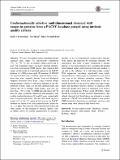Conformationally selective multidimensional chemical shift ranges in proteins from a PACSY database purged using intrinsic quality criteria
Author(s)
Schmidt-Rohr, Klaus; Fritzsching, Keith J.; Hong, Mei
Download10858_2016_Article_13.pdf (3.630Mb)
OPEN_ACCESS_POLICY
Open Access Policy
Creative Commons Attribution-Noncommercial-Share Alike
Terms of use
Metadata
Show full item recordAbstract
We have determined refined multidimensional chemical shift ranges for intra-residue correlations ([superscript 13]C–[superscript 13]C, [superscript 15]N–[superscript 13]C, etc.) in proteins, which can be used to gain type-assignment and/or secondary-structure information from experimental NMR spectra. The chemical-shift ranges are the result of a statistical analysis of the PACSY database of >3000 proteins with 3D structures (1,200,207 [superscript 13]C chemical shifts and >3 million chemical shifts in total); these data were originally derived from the Biological Magnetic Resonance Data Bank. Using relatively simple non-parametric statistics to find peak maxima in the distributions of helix, sheet, coil and turn chemical shifts, and without the use of limited “hand-picked” data sets, we show that ~94 % of the [superscript 13]C NMR data and almost all [superscript 15]N data are quite accurately referenced and assigned, with smaller standard deviations (0.2 and 0.8 ppm, respectively) than recognized previously. On the other hand, approximately 6 % of the [superscript 13]C chemical shift data in the PACSY database are shown to be clearly misreferenced, mostly by ca. −2.4 ppm. The removal of the misreferenced data and other outliers by this purging by intrinsic quality criteria (PIQC) allows for reliable identification of secondary maxima in the two-dimensional chemical-shift distributions already pre-separated by secondary structure. We demonstrate that some of these correspond to specific regions in the Ramachandran plot, including left-handed helix dihedral angles, reflect unusual hydrogen bonding, or are due to the influence of a following proline residue. With appropriate smoothing, significantly more tightly defined chemical shift ranges are obtained for each amino acid type in the different secondary structures. These chemical shift ranges, which may be defined at any statistical threshold, can be used for amino-acid type assignment and secondary-structure analysis of chemical shifts from intra-residue cross peaks by inspection or by using a provided command-line Python script (PLUQin), which should be useful in protein structure determination. The refined chemical shift distributions are utilized in a simple quality test (SQAT) that should be applied to new protein NMR data before deposition in a databank, and they could benefit many other chemical-shift based tools.
Date issued
2016-01Department
Massachusetts Institute of Technology. Department of ChemistryJournal
Journal of Biomolecular NMR
Publisher
Springer Netherlands
Citation
Fritzsching, Keith J., Mei Hong, and Klaus Schmidt-Rohr. “Conformationally Selective Multidimensional Chemical Shift Ranges in Proteins from a PACSY Database Purged Using Intrinsic Quality Criteria.” J Biomol NMR 64, no. 2 (January 19, 2016): 115–130.
Version: Author's final manuscript
ISSN
0925-2738
1573-5001